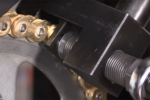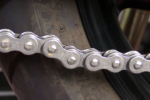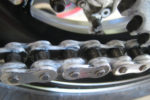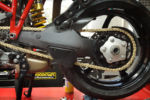Your chain needs to be adjusted properly. Of course, your owner’s manual will have exact requirements for your bike, but the rule of thumb is about 1 to 1.5 inches of slack. But what does that mean and why is that important? Slack is how much the chain will move up and down freely at a point halfway between the two sprockets.
You need slack because as your swingarm moves up to compress for a bump, the chain gets tighter. When a chain is too tight, it will bind on the sprockets, causing quicker wear of both chain and sprockets. A tight chain will also, over time, ruin your countershaft and your countershaft seal (the seal around the shaft that carries the front sprocket) and may even bend the countershaft. Also, a tight chain is more likely to develop tight spots. Tight spots are portions of the chain that stretch at different rates and cause binding between links. So, why not just run the chain really loose? Well, too loose and the chain runs the risk of flying off the sprockets. Bad news! Also, too loose causes a lot of slop in the driveline. Example: twist the throttle, short delay, then lurching as the chain snaps tight, then loose until you are under heavy acceleration. Chain adjustments are very important, even though it may not be something you need to do very often.
If your chain requires adjustment, your owner’s manual will have the information you need to tighten/loosen it as there are many different types of adjustment. You will probably need to start by loosening the axle to allow the wheel to move. Then you can turn the adjuster screws, ¼ turn at a time, until you reach the proper adjustment. I like to turn the left one, and then turn the right one the same distance to maintain wheel alignment.
When you achieve proper slack, you need to make sure the wheel alignment is still correct. If the wheel is crooked in the swingarm, your chain and sprockets will wear really rapidly and you can even get into strange handling characteristics. There are two ways to measure alignment. You can grab a flexible tape measure (like what tailors use) and measure from the center of your axle to the center of the swingarm pivot. Or you can string your bike up. Stringing requires you to get a really long piece of string and wrap it around the front tire. Then pull the lengths of string back toward the rear wheel. You can then use your calibrated eyeball to compare the strings with the alignment of the wheels. If your wheel is out of alignment, it will be pretty obvious. I have had a lot of success using the tape measure method. I think it’s quicker and more accurate.
After you are confident with your alignment, tighten everything up and check the slack again. Many bikes will tighten chain slack when everything is snugged back down.






